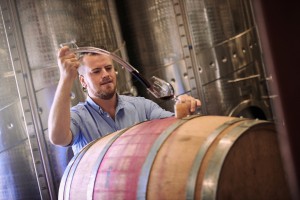The Winemaker’s Think Tank: Vol 33 – “What are Malo lactic bacteria and when do I add them?”
What’s the Winemaker’s Think Tank?
Every Thursday we will post about a few frequently asked questions that our winemaker has answered. If you have a winemaking question you would like to have answered, please email us at support@juicegrape.com and we will try to get into next week’s post. Cheers! 🙂
What are Malo lactic bacteria and when do I add them?
Malo lactic bacteria are a specific strain of bacteria from the Lactobacteriaceae family, typically Oenococcus. These bacteria perform a secondary fermentation, in which they consume malic acid and process it into lactic acid and carbon dioxide. This process is necessary for most reds and sometimes used in Chardonnay production, depending on the winemaker’s stylistic choice. This secondary fermentation processes the more astringent malic acid into the more favorable lactic acid which gives the wine a creamier mouthfeel and more of a mid-palette balance. For Chardonnay it reduces the predominant apple flavor and yields a richer, buttery flavor.
Malo lactic bacteria have a few critical factors to lead to their healthy, successful fermentation. The bacteria favor an environment that has a pH greater than 3.2. They like a warmer temperature environment of above 60°F. They are able to withstand a bit of SO₂, but no more than 50ppm, less than that being ideal. They also have an alcohol tolerance of less than 16%. Each strain of malo-lactic bacteria has its own parameters within which it is most effective. It is important to evaluate these factors when selecting your strain of bacteria to ensure its ability to complete the fermentation.
There are several modes of thought as to the timing of the inoculation of the malolactic bacteria. For the novice winemaker, the inoculation of bacteria after primary alcoholic fermentation is complete may be more advantageous as the will be only one fermentation going on at a time, causing fewer variables to monitor on behalf of the winemaker. Because the yeast has consumed many of the nutrients available to them during primary fermentation, there will be less nutrients available to the bacteria to assist them in conducting malolactic fermentation. A bacterial fermentation nutrient such as Opti-malo Plus should be used to give them the proper nutrition they need to finish their fermentation. Yeast also partially metabolize malic acid throughout their fermentation process; inoculating the bacteria after alcoholic fermentation is complete eliminates the competition for that nutrient for either fermenting agent (yeast or bacteria).
After discussing the benefits of conducting MLF after primary fermentation, there are equally, if not more benefits to co-inoculating the bacteria with the yeast during primary fermentation. It is a popular mode of thinking to inoculate bacteria at 2/3 depletion of Brix levels; the yeast have already passed their exponential growth phase and are on the latter half of their work load. The yeast fermentation will be over the peak in activity which causes dramatic spikes in temperature yet will still be producing some heat to create a nice warm environment for the bacteria to live. With the primary still not yet complete, there will be more nutrients (amino acids, tannins, minerals) to assist the bacteria in their fermentation. This is not to say that the winemaker should not use a malolactic nutrient. The nutrients are still critical in ensuring a through malolactic fermentation. Another benefit of co-inoculation is the aspect of time. By adding the bacteria early on, the malolactic fermentation will complete earlier than if the winemaker were to wait and begin the bacterial fermentation after primary fermentation is complete. This is less time that the wine is without sulfites and at risk of oxidation. As previously mentioned, the yeast also metabolize between 10-40% of the malic acid content within the grapes. By introducing the bacteria earlier, they will have potentially have access to more malic acid, which they will convert to lactic acid, resulting in a creamier, softer mouthfeel. Another benefit of earlier introduction is a lower concentration of alcohol by volume. Most bacteria function best below 16% ABV, so when fermenting a wine that will potentially be high in alcohol, early inoculation may be critical to give the bacteria a head start against the rising alcohol levels. As with most things in life, there is a downside to having a high concentration of lactic acid: lactic acid bacteria. There are bacterial strains that feed on lactic acid and can generate sauerkraut or tart yogurt flavors, regarded as a wine fault.
Another frequently asked question regarding MLF, is how does the winemaker know when it is complete? There are two ways to test for the completion of this fermentation at home. One way is to use a malic acid test to test for any residual malic acid left in the wine. These tests are relatively simple to conduct by the home winemaker, with simple malic acid test kits available for home use for under $50 (includes 10 individual tests). This test is slightly limiting as it will simply test for the presence of malic acid. If the winemaker wants to do a partial MLF on a Chardonnay, for example, this test may not be as useful. Paper chromatography is the preferred method of testing to see if MLF is complete. The kit is more expensive, $90, but will potentially yield hundreds of test. The benefit of this test is the winemaker can then compare the amount of malic vs lactic acid in the wine and see the proportional transition. This will better assist the winemaker in deciding when to stop the fermentation if they wish to do a partial ferment on a Chardonnay. Lastly, for the incredibly detailed, expert home winemaker, they may send a sample to an outside laboratory for analysis. The lab can give them acid quantities present in the wine as well as confirmation of the completion of the fermentation process.
In summary, while there are a myriad of opinions on the timing of the introduction of malo-lactic bacteria, there is no wrong one. The novice winemaker may want to post pone the introduction of the bacteria until primary fermentation is complete to reduce the amount of variables to monitor. The inoculation of the bacteria during the primary fermentation may be more beneficial for the bacteria and the resulting wine, however requires more careful monitoring. As long as the bacteria have proper temperatures and nutrition needs are met, they will conduct a successful secondary fermentation.
We hope this information helps with your winemaking. If you have any follow up questions or winemaking questions in general, please email us at support@juicegrape.com.










Recent Comments